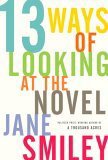
After a couple weeks on a NYPL wait list, I finally got my hands on Jane Smiley's 13 WAYS OF LOOKING AT THE NOVEL, and I'll barely finish it in time to return it. It's big, it's dense, and it's been worth every second of my time. And I can't just renew it, it's a hot ticket item in our burg. (Question, are all the others on the waiting list writers too? Just how many of us are there?)
I'm buying it when it comes out in paperback, because it's a great reference book for any writer's shelf. Smiley read 100 novels, from THE TALE OF GENJI to WHITE TEETH, and recaps each in the 300-page 13th chapter of the 570-page book. While Smiley's recaps do fit the novels into a historical continuum, they are not academic. They are experiential, and come from a love of reading.
Smiley's list goes beyond the canon of American literary education, and she's got me jazzed to read a few older works I hadn't heard of before: THE HEPTAMERON, by Marguerite de Navarre; ZENO'S CONSCIENCE by Italo Svevo; KRISTEN LAVRANSDATTER, by Sigrid Undset. (All of these happen to be works in translation, and Smiley provides info on the edition of each novel she read.) I'm also inspired to read some more familiar stuff I never got around to: Proust's 7-volume quasi memoir (Smiley calls his narrator a "kindly narcissist"), and Forster's A PASSAGE TO INDIA, which has themes of particular interest in contemporary times, with the legacy of colonialism still playing out in our daily lives.
Her recaps are daring too. I nearly gasped when I read her suggestion that THE GREAT GATSBY should have been 100 pages longer, that it suffers from the shallow-character problem shared by many writers in their twenties. After so many years of living in the standard assumption that GATSBY is the pinnacle of American literary achievement, it was refreshing to hear this opinion, and in retrospect, it rings true to me.
The first 12 chapters of Smiley's book are thematic ruminations on the novel and its evolution. She defines the novel as a "lengthy prose narrative with a protagonist," which is the bare skeleton of this big analysis. One of the most interesting themes that she returns to repeatedly in the first 12 chapters is women and marriage, or the big question: can a woman act on her desires and still be virtuous?
My favorite of the thematic chapters is a case study of her writing process for GOOD FAITH. In a way, the relationship between a writer and her work is like romantic love: sometimes it's a honeymoon, sometimes it's a matter of pragmatism and/or habit. GOOD FAITH wasn't one of her honeymoon books, and since I'm in the process of revising a novel I kind of can't stand, this chapter comes at a very good time for me. Smiley advises:
If the novelist especially likes a book or feels a kinship to it, his attachments blind him to the independence of the novel and make him feel that his views about the novel are more primary or more important than other readers' views. In fact, they are only different. When I published a novel that I was satisfied with but did not like, I saw that no novel can help communicating many things to every reader, and that the novelist's ideas about what is being communicated are as valid as any reader's ideas, but no more so.
Thanks, Ms. Smiley, for helping me over this hump. And reminding me that I don't have to be on a honeymoon with this darn writing project every second of the day. That it may still have value, even though it's hard to see through the haze between me and my screen. And that I don't have to be in charge of what that value is. I only have to write the story.
I highly recommend this book, especially if you are working on a novel. Makes me realize how much the workshop system is skewed to short stories, which is a little strange given the appetite of most of the reading public for longer works. It's helpful to focus on "what is a novel" for 570 pages, to remind myself that everything can't be a honed, compact nugget. Some things need to spread out and breathe. And some writing projects take years, not months.
P.S. Check out Smiley's radio interview with Michael Silverblatt...
2 comments:
Thanks for this. I may have to locate this book, too. Unlikely to be in my little library, but we'll see. Sounds useful.
Excellent review, Anne. I'm going to see if I can get the paperback.
Post a Comment